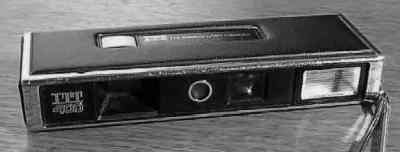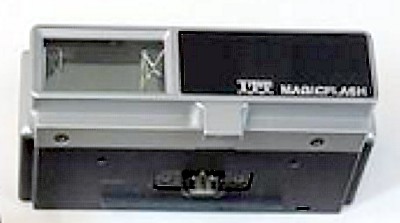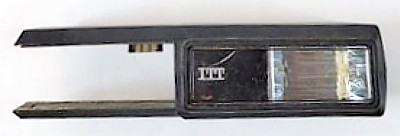
ITT 110 CAMERAS


while others were made to clip on to the end of specific 110 cameras -- but not the ITT 110 cameras below.

To add to the confusion, most ITT cameras do not have the model name or number on the camera itself -- ONLY on
the box!!! They are simply called "Magicflash" or "Fashionflash". The good news is that they
accept 100 & 400 speed film.
If you are able to provide more accurate information than is listed here, please contact us.
ITT's simplest 110 camera is a basic model with a built-in flash using two AAA batteries. It only has one shutter speed -- 1/90 -- and its aperture is set at 9.5, changing to 6.3 when the integrated electronic flash is used.
(1979) This guy has a 30mm glass, three-element, fixed-focus lens which is set at f9.5 for normal use and f5.6 for flash. It has a single shutter speed of 1/90 and a built-in flash which uses two AA batteries and recycles in under 10 seconds. The flash is good to about 10 feet. Built-in lens and viewfinder cover.
Another step up, this model adds a telephoto lens that can be switched into place with a lever on the top plate.
A stylish, rounded-ends 110 with a pull-apart design to protect the lens, and advance the film in the Minox style. It comes with two lenses -- a 22mm (f5.6-16.0) and a 44mm (f5.6-16.0). Fixed shutter speed of 1/125. With ISO 100 film, the aperture is set to f8. With ISO 400 film, the aperture is set to f16. With flash, the aperture is set to f5.6. Built in flash. Comes in a beige body with yellow and orange stripes. Uses two AA batteries.
It's the same as the 405-B, but in "silver" with blue and green stripes.
A total different ITT 110 model -- and not just because it has no flash. First, it has an 80mm f11, fixed-focus lens and a single, mechanical, shutter speed of 1/125. No exposure control. The camera looks like a binocular/camera combination. The binoculars are fake, but because of the 80mm lens, the results are telephoto -- about 150mm in full-frame 35mm. There is a small viewfinder underneath the camera lens -- which is on the top-center of the fake binoculars. Dimensions of 2-1/8 x 4 x 3-3/4 in. Focusing wheel and tripod socket on the bottom, and shutter release button with cable release socket on the top. Also sold as the American Rand Photo Binocular 110 and the Sedic Tele-Spot 110 -- collect all THREE!!!.

To return to the main index for the Sub Club click here.
COPYRIGHT @ 1995-2024 by Joe McGloin. All Rights Reserved.